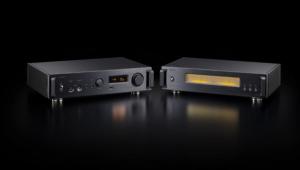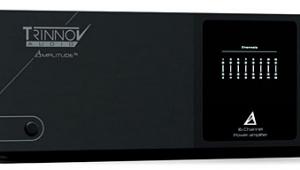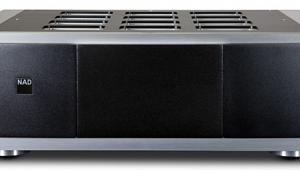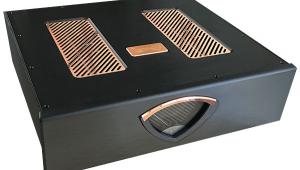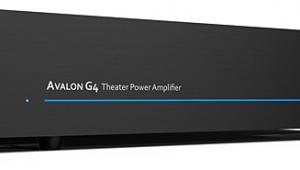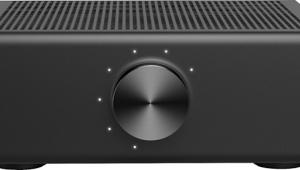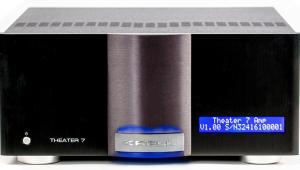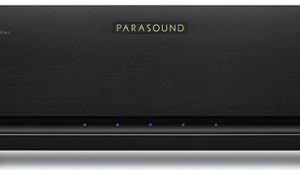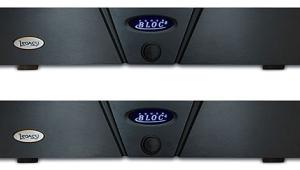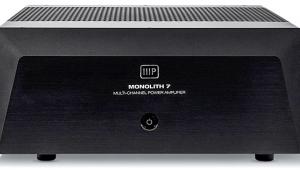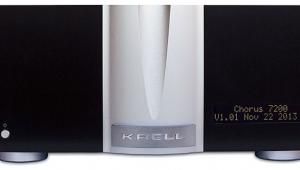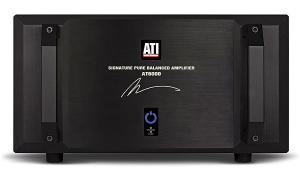Parasound Halo C 2 & Halo A 51 surround processor & 5-channel power amplifier Page 2
The C 2 offers four modes of basic audio: Mono, Stereo, Direct (in which any digital input is decoded in its own format), and Stereo96 (an upsampling mode that uses the C 2's advanced digital processing). No tone-control adjustments or bass management are available in Stereo96 mode. In addition, the Audio 1 balanced inputs can be used in Bypass mode, which sidesteps all of the C 2's electronics except for the analog volume control—a feature that, like the 7.1 analog input/output function, makes the C 2 an excellent choice for those who wish to incorporate a purist audiophile system within a multichannel home theater.
Dolby modes include Pro Logic, Pro Logic II (Movie and Music), and Dolby EX. DTS modes include ES Matrix and Discrete, Neo:6 (Cinema, Music, and Matrix), and DTS 96/24 (reproduced at 48kHz). THX post-processing includes THX Cinema, THX Surround EX, THX Ultra2 Cinema, and THX Ultra2 MusicMode. Parasound also includes four proprietary surround fields: Natural, which generates surround sound from any 2-channel input; Party, which balances the sound in the room by duplicating the left/right front signals in the left/right surrounds; Club, which adds a user-adjustable amount of reverberation to stereo signals to increase the apparent size of the acoustic space; and Concert, which functions similarly but creates the illusion of a larger space.
My home theater is configured as a 5.1 system, with cables buried in the walls. A window on the left side of the seating area and an open hallway on the right side make it impossible to install speakers for a 7.1 system, so I didn't experiment with any surround modes requiring more than 5.1 channels. Relatively few films are encoded with any of these modes, and most of them aren't likely to become widespread standards of the stature of Dolby Digital 5.1.
I found that I preferred listening to most music videos (and movies without a Dolby Digital 5.1 or DTS 5.1 soundtrack) in either the Direct or the Pro Logic II Movie mode. Finnish electronics engineer Juha Kuusama, who was intimately involved in the C 2's design, told me that he found the Pro Logic II Music mode most appropriate for classical recordings made in large concert halls. Playing Diana Krall's Live in Paris concert DVD, I felt that the PL II Music mode threw too much of the instrument sounds into the surrounds—hearing the piano and guitar behind me while seeing them onscreen in front of me was too much cognitive dissonance. PL II Movie mode sounded much more natural, with the proper "proscenium" perspective and just enough hall ambience.
 For music listening, I quickly became addicted to the C 2's Natural mode. Unlike the derived-surround modes found in many home-theater receivers, it didn't sound hokey and provided a really enjoyable enhancement of ordinary stereo. Kuusama said that the C 2 design team took special care in creating this mode, and it showed. "The Natural mode sounds so good because it doesn't alter the stereo signal," Parasound president Richard Schram told me. The center-channel feed is derived from left/right common signals, and the rear/surround is derived from whatever decay or ambience is present in the recording. The effect varies from subtle to startling depending on the recording, but I always found it preferable to straight stereo. Call me a hi-fi heretic.
For music listening, I quickly became addicted to the C 2's Natural mode. Unlike the derived-surround modes found in many home-theater receivers, it didn't sound hokey and provided a really enjoyable enhancement of ordinary stereo. Kuusama said that the C 2 design team took special care in creating this mode, and it showed. "The Natural mode sounds so good because it doesn't alter the stereo signal," Parasound president Richard Schram told me. The center-channel feed is derived from left/right common signals, and the rear/surround is derived from whatever decay or ambience is present in the recording. The effect varies from subtle to startling depending on the recording, but I always found it preferable to straight stereo. Call me a hi-fi heretic.
The C 2's internal DACs are state-of-the-art. Its performance in Stereo96 mode was nearly the equal of my Perpetual Technologies P-1A/P-3A combo, giving ground only in image focus and bass delineation. Kuusama told me that Parasound achieves a high signal/noise ratio—and, therefore, excellent detail and resolution—by using a minimum number of microprocessors and DACs. Other manufacturers get advertising mileage out of using paralleled DACs or multiple CPUs, a technique he claims adds noise "like hundreds of air-conditioners running on an hot day."
Two Units in One
The C 2's Zone B will be a welcome feature for anyone who wants to feed music to more than one location in the home. Custom installer Bernie Kepke and I spent an afternoon experimenting with the Zone B functions, with the C 2 driving an old Sony receiver. Once we got a grasp on it, it worked flawlessly.
The simplified SideKick remote (which is part of the customized MX-700 dual-remote system) works as a Zone B controller if you press Zone before pressing the volume up/down buttons or any other function. Otherwise, it controls the primary zone. This might be problematic if a guest doesn't know to first press Zone and instead gooses the volume in the main system. A dedicated Zone B remote is a useful accessory for users with distributed systems; Denon includes one with its home-theater receivers.
Another Small Glitch
The owner's manual states that the C 2 accepts "an IR sensor." We took that literally and quickly discovered that there's no way to plug an IR sensor directly into the C 2. What the pre-pro is actually looking for is the full flasher output from a Niles IRP2+ "brain box" (or Xantech equivalent) using a two-conductor cable with a miniplug instead of an IR flasher. (I've been told that new versions of the owner's manual have already cleared this up.) Zone B is entirely independent of the primary zone, and will function even if the main unit is off. In this case, the display will read, simply, "zone b." All inputs are available for Zone B except Bypass and 7.1. As mentioned, the video feed to Zone B is composite only.
Conclusions
All things considered, the Parasound Halo C 2 is a wonderful piece. It's gorgeously designed, marvelously versatile, and it sounded fantastic. It's intended to satisfy both the fussy audiophile and the home-theater fanatic—an almost impossible task, but one that Parasound can be proud of achieving. Even after three months with it, I was still discovering new tricks it could do. And, like every Parasound product I've ever encountered, it's rock-solid and totally reliable.
Although few consumers will use all or even most of the C 2's capabilities, they're there if needed. Like a personal computer or Swiss Army knife, it's ready to do far more than you'll ever need it to do. The C 2 is future-forward in every respect and should find its place as the heart of many a high-perfor-mance home theater system. I owned Parasound's D/AC 2000 and P/LD 2000 until just recently, having spent more than five very satisfied years with them. I expect the C 2 will remain in my system for just as long. It's that good.
HALO A 51 POWER AMPLIFIER
Direct-coupled throughout—no capacitors or inductors to besmirch signal purity—the Parasound Halo A 51 power amplifier delivers a full 250W per channel into 8ohms loads and a mind-boggling 400x5 into 4ohms loads. JFET input circuitry and a complementary-MOSFET driver stage ensure speed and transparency. Crosstalk is kept to a minimum, partly through the use of separate power-transformer windings for each channel, and reliability is boosted by the use of 40 gain-matched 15A/60MHz bipolar output devices.
The A 51 can be powered on by the front-panel power switch, by a 12V trigger, or—if the music sensor switch on the back panel is engaged—by an input signal. Clear evidence of the amp's solid design is that, unlike many other amplifiers, its sound when cold was not much different from its sound when fully warmed up. None of that "it has to play for three hours before it sounds good" nonsense with the A 51.
Most of the time, the A 51 ran warm to the touch but not hot, regardless of how hard I drove it. I kept it on almost continually for three months (March through May), and it wasn't until the air temperature reached the high 80s that the A 51 began to feel hot. A low-speed oscillating household fan took care of that, without any annoying noise. (Remember, the equipment is in another room from the theater.)
The only qualm I had with the A 51 was with the arrangement of the output terminals. The amp's sides and back are covered with heatsinks, and the output terminals are so closely spaced that inserting bare wires requires a surgeon's skill. If you're inclined to stack connectors for biwiring, I caution you to take great care in doing so. It would be all too easy to short out a channel with a sloppy connection. The placement of the handle near the output connectors makes the problem worse. Mounting it farther toward the outside would provide more room. Snug-fitting, lock-in-place banana plugs are best with this amp, and Parasound thoughtfully supplies them.
Sound
The A 51 was the first of the two Halo components that went into my system, replacing an unusual but extremely musical biamp combination of a Red Rose Model II Silver Signature tube amp driving the midrange and high frequencies on my custom-made PBN Montana EPS speakers, and a big solid-state amp of my own construction driving the bottom end (think big toroidal transformer, massive capacitor bank, heavy-duty bipolar output devices). This combo has long given me everything I want in 2-channel sound: delicate, airy detail, sweet harmonics, and authoritative bass.
As with the C 2, I expected the A 51 to sound good—with its John Curl design pedigree and close kinship to Curl's esteemed JC-1, I could expect no less. What I wasn't prepared for was how good the A 51 sounded right out of the box. For the first two days it was in the system, I plowed through my CD collection, eagerly hunting out old favorites just to enjoy this amp's pure musicality. "I can't believe how good this sounds," I kept gushing to Robyn and several audio buddies who cruised by to check out the review gear. The A 51 got very close to the Red Rose in terms of absolute harmonic rightness—you know it when you hear it—and trounced my homemade amp in the departments of dynamic headroom and bass impact. Its midrange was totally seductive, its soundstaging and imaging abilities in the same league as some of the best gear I've ever heard at any price.
If that 2-channel test drive had me thinking about buying the A 51, the multichannel experience made me want to slap down my Visa card. The recent multichannel SACD reissue of Pink Floyd's Dark Side of the Moon was a revelation, and the helicopters and battle scenes in Black Hawk Down gave me a new understanding of cinematic realism. With music, the A 51 radiated sweetness and light. With action films, it rained thunder and lightning. There aren't many amplifiers that can so effortlessly cover both ends of the sonic spectrum.
For a few weeks, I had a Pass Labs X5 for comparison. Of similar size, the X5 delivers only half the power (125Wx5 into 8ohms) of the A 51, and it costs $500 more. I thought the Pass perhaps sounded just a tad more delicate on some recordings, but not sufficiently so to tip the scale in its favor. With most recordings, the two amps were so similar in that department that it would be just about impossible to tell them apart. The A 51 was the hands-down winner in midrange liquidity, sheer power, dynamic capability, and bass authority. Those qualities—and a 25% difference in price—make the A 51 the clear choice in my book.
Conclusions
Beautifully designed and skillfully executed, Parasound's Halo A 51 is all the amp anyone could need—unless, of course, you're off in 7.1-channel land. In that case, add a Halo A 21, the 2-channel sibling, and you are there. I can't imagine any audiophile—2-channel traditionalist or multichannel adventurer—being unhappy with the A 51. Neither could I imagine any movie fanatic finding anything to fault in its style or performance.
The A 51 and C 2 form an unbeatable combination—one that I intend to enjoy for a very long time. They exemplify elegance, ease of use, near-universal compatibility, and what appears to be bulletproof reliability—backed by 10-year parts and 5-year labor warranties. Both get my highest recommendation. Richard Schram & Company deserve accolades for bringing them to market.
- Log in or register to post comments
